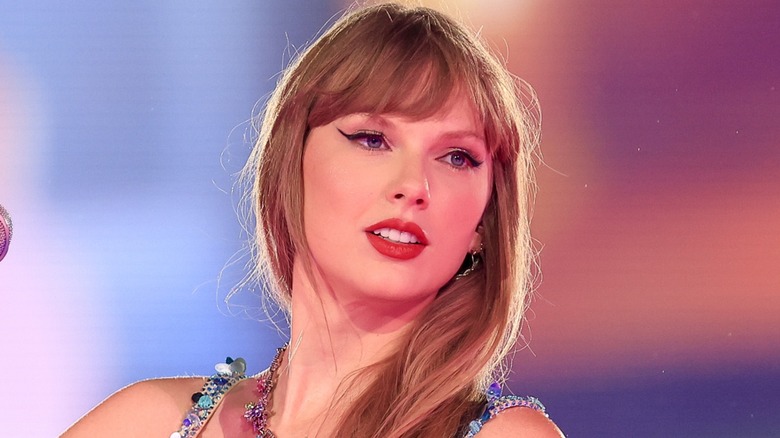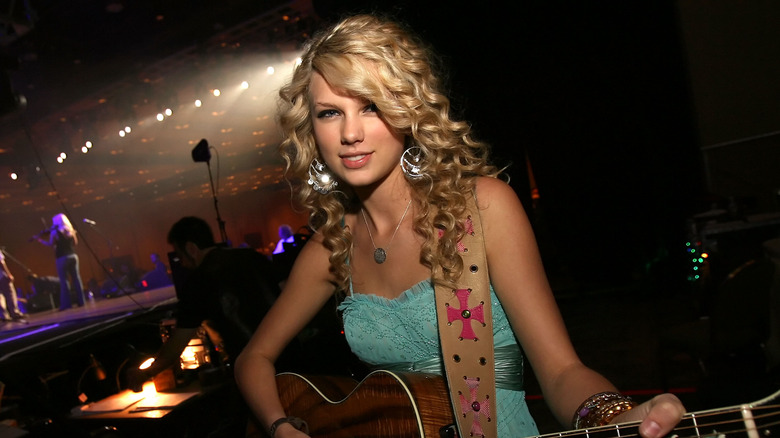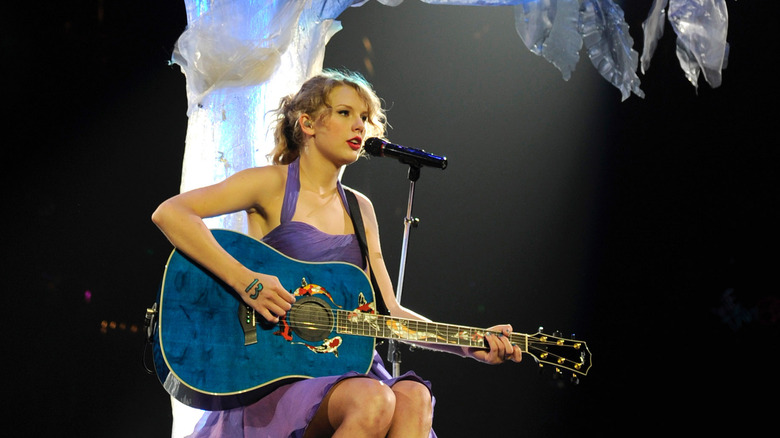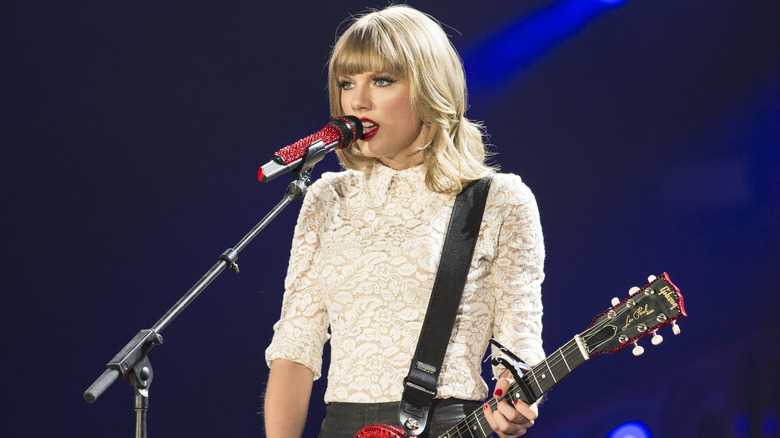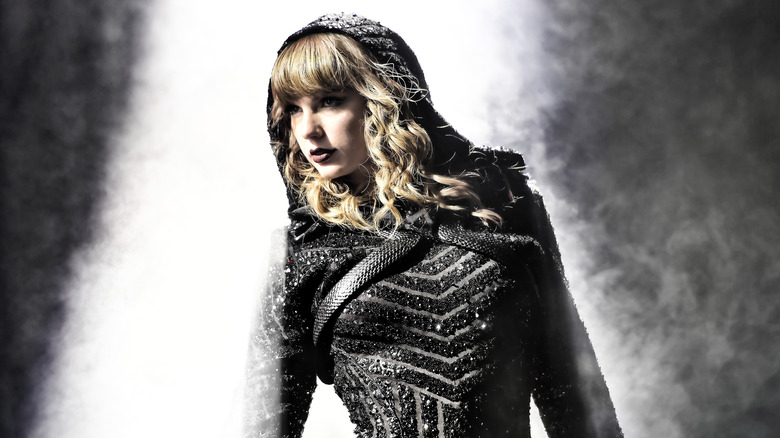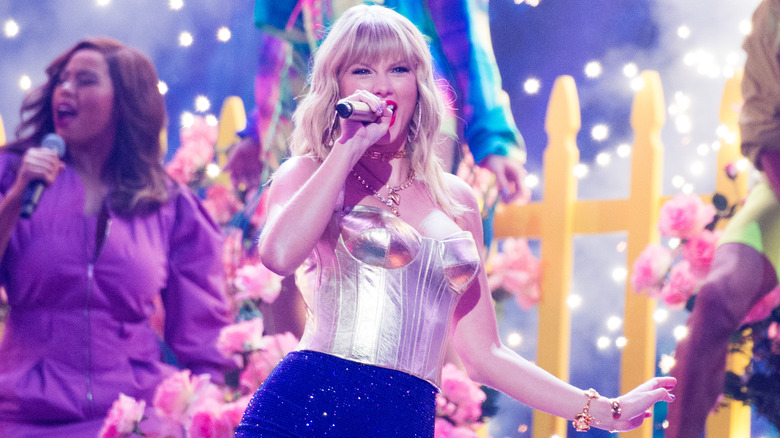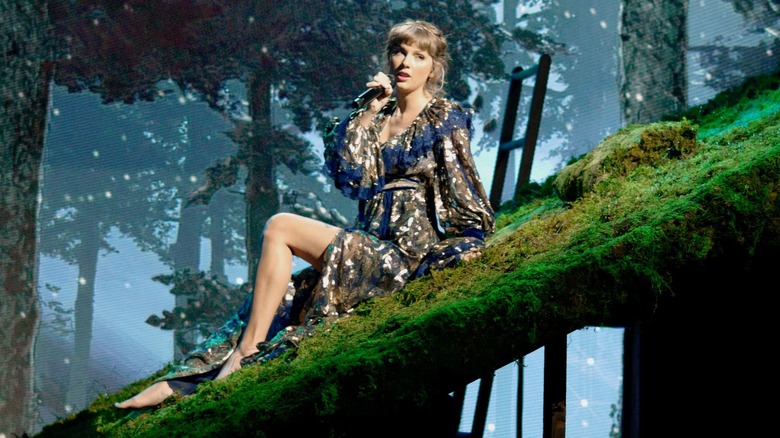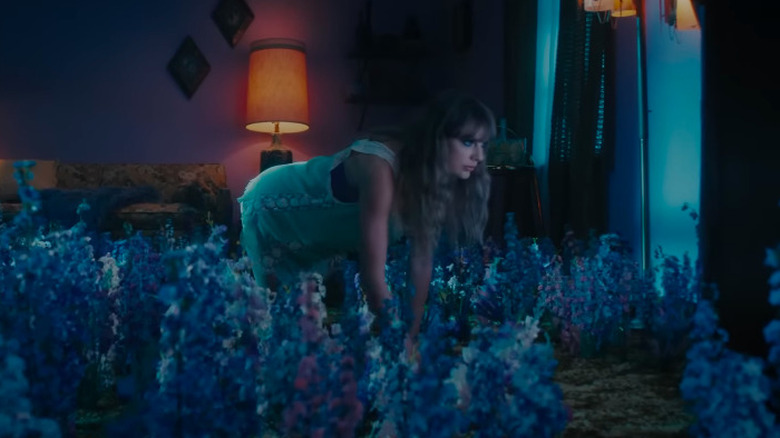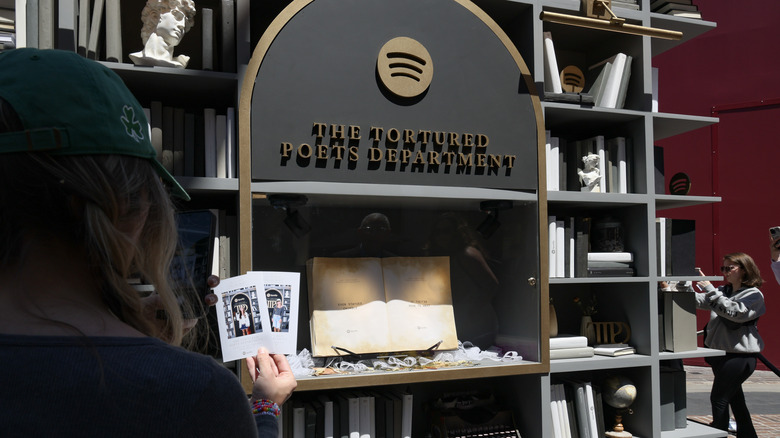Inside Each Of Taylor Swift's Eras
She may have once been known for the teardrops on her guitar, but Taylor Swift doesn't have too much to cry about nowadays. After all, the small-town girl who launched her career with the hit song "Tim McGraw" nearly two decades ago has become one of the richest and most successful pop stars in the world. Many love her, some may hate on her, but just about everyone knows her name.
While the "Fearless" singer first debuted as a country singer, she has continued to reinvent herself in her lengthy career, delving into country-pop, pop, indie-folk, and electro-pop styles without ever losing her loyal fanbase. Instead, she has only cemented her status as a force to be reckoned with. She's the only artist to have ever won four album of the year Grammy Awards, and at 34 years old joined the ranks of the Forbes World's Billionaires List.
Many have likened Swift's genre-changing albums and musical evolution as an artist to her ever-changing "eras," something she capitalized on when she launched her Eras Tour in 2023. The tour was a highly-grossing global trek across the world that nodded to Swift's changing styles across her career, celebrated by her friendship-bracelet-wearing Swifties. From country bumpkin to tearful poet — here's a look inside each of the singer's eras.
Taylor Swift launched her career in country music
The year was 2006. Low-rise jeans, embellished crop tops, and belted dresses were the talk of the town — and so was Taylor Swift. Her discography began with the release of her debut album, "Taylor Swift," featuring her as a 16-year-old with big dreams. With her perfectly coiffed curls, side bangs, and signature guitar strapped to her shoulder, Swift geared up to take the world by storm.
Her track, "Our Song," rose to No.1 on the country charts, with her first music project producing several other hit singles, including "Teardrops On My Guitar," "Picture to Burn," and "Tim McGraw." Swift co-wrote all the songs off her self-titled album while she was still in high school, experiencing love and heartbreak for the first time. Lyrics like, "She'd better hold him tight, give him all her love / Look in those beautiful eyes and know she's lucky 'cause / He's the reason for the teardrops on my guitar," told the story of a vulnerable girl chasing after an unattainable crush, a relatable journey that shed light on her girl-next-door persona.
Swift's country era was a nod to the singer's upbringing as a small-town girl in Pennsylvania who grew up listening to the likes of the Chicks, Faith Hill, and Dolly Parton. She donned the stage in flowy dresses, cowboy boots, and bangles on her wrist, with an air of teenage innocence. While we may never see a fully country T-Swift again, the era marked the beginning of a show-stopping career.
Her Fearless era was filled with youth and romanticism
Released in 2008, Taylor Swift's highly-anticipated sophomore album, "Fearless," ushered in a coming-of-age era filled with both the optimism and heartbreak that young love often brings. "'Fearless' was an album full of magic and curiosity, the bliss and devastation of youth," Swift reminisced in 2021 (via the Los Angeles Times). "It was the diary of the adventures and explorations of a teenage girl who was learning tiny lessons with every new crack in the facade of the fairytale ending she'd been shown in the movies."
The album debuted at No. 1 on the Billboard 200 chart with the help of international smash hits like "You Belong With Me," "Love Story," and "Fearless." The sound of the record cemented Swift's crossover into pop, while still holding on to the country undertones that first made her famous. The "Fearless" album was a major success, becoming the longest-running album at the No. 1 spot that decade and the most awarded country music album in history.
The "Fearless" era brought with it sequin fringe dresses that came alive on stage, romantic ball gowns, and her signature lucky number 13 that she often drew on the back of her hand. "I was born on the 13th. I turned 13 on Friday the 13th. My first album went gold in 13 weeks," she explained to MTV in 2009. The era was complete when Swift earned her first Grammy for album of the year, with "Fearless" winning a total of four statues.
Speak Now further proved her skill as a writer
Taylor Swift's "Speak Now" album showcased the singer's talent as a powerful songwriter. The record, released in the fall of 2010, was written in full by Swift without the help of a co-writer. She released the album at 20 years old, and it marked a point in her life where she was able to have the last word, reframing the trials and tribulations of her young adult life under the scrutiny of the public microscope.
"It's an album I wrote alone about the whims, fantasies, heartaches, dramas, and tragedies I lived out as a young woman between 18 and 20," she wrote (via Billboard) upon its re-release in 2023. "I remember making tracklist after tracklist, obsessing over the right way to tell the story."
Swift's "Speak Now" era was marked by enchantment, whimsical romance, and theatrical-like performances inspired by the singer's love of Broadway. The album's tour was complete with acrobatic performers, lit trees, overwhelming costume changes, and scene changes that kept the audience at rapt attention. She remained true to her country roots with her hit track, "Mine," and offered fans a softer vibe with the acoustic track, "Never Grow Up." While she still had her air of innocence, the album proved the "Story of Us" singer had learned a few lessons during her time in the spotlight.
The Red era introduced an edgier style
With the dawn of Taylor Swift's "Red" era came a sharper and edgier look for the singer/songwriter. Long gone were the artist's tightly wound curls, and in its place were blunt bangs, straight hair, bold red lips, hats, and more mature outfit choices. Swift released the album in October 2012, and her genre-mixing proved to be a success, with the singer earning herself her first No.1 hit on the Billboard Hot 100 chart with the track, "We Are Never Ever Getting Back Together."
"Red" had Swift steering even more in the pop direction, with much debate as to whether she could still be considered a country artist. While crafting the project, she worked with famed pop writer Max Martin and producers who had previously worked with icons like P!nk and Britney Spears. She crafted up-tempo, EDM-inspired beats and catchy chant-worthy songs, saying goodbye to her good-girl persona and offering fans a newer, fresher perspective on womanhood. Her tracks like "I Knew You Were Trouble" and "All Too Well" paint her in a different light as she sings about being a "new notch" in someone's belt, and about mourning the loss of an ex who took advantage of her youth.
"Musically and lyrically, Red resembled a heartbroken person," Swift tweeted during the album's 2021 re-release. "It was all over the place, a fractured mosaic of feelings that somehow all fit together in the end. Happy, free, confused, lonely, devastated, euphoric, wild, and tortured by memories past."
Swift reinvented herself as a full-on pop star with 1989
While she had dipped her feet in pop music in previous records, "1989" was tapped to be Taylor Swift's first official foray into purely pop music. Named after her birth year, the project dropped in 2014, full of punchy, weaponizing, lyrics that were addicting to sing along to. Viral chart-topping hits like "Blank Space," "Shake It Off," and "Bad Blood" sent the message that she wasn't going to take any more jabs about her dating life lying down. Instead, she would simply shake them off.
Swift stood on her throne, hair chopped in a blunt bob, no longer going to be painted as the boy-obsessed songwriter subjected to misogynistic jabs and shaming. "The risks I took when I toyed with pop sounds and sensibilities on 'Red'? I wanted to push it further," she wrote in the album's prologue (via Today). "The sense of freedom I felt when traveling to big bustling cities? I wanted to live in one. The voices that had begun to shame me in new ways for dating like a normal young woman? I wanted to silence them."
The "1989" era ushered in the bustling vibes of her New York City apartment, newfound girl squad, and more daring outfits — putting her small-town country persona to bed. The record became her highest-selling album to date and cemented her status as a global pop phenomenon. Plus, it gained Swift three more Grammy Awards, including her second album of the year win.
'The old Taylor' died when Reputation debuted
Taylor Swift was involved in some major beef in 2016 — a feud that became the fuel for her infamous "Reputation" era in 2017. While she made nice with Kanye West after his interruption at the 2009 VMAs, their drama reignited in 2016 when West mentioned Swift in his track, "Famous." Essentially, the singer insisted that she never approved of his "I made that b***h famous" lyric, while West's then-wife, Kim Kardashian, attempted to prove her wrong by releasing Snapchat videos of a phone conversation between Swift and the rapper.
Swift took a major step back from the spotlight after the public backlash but returned with the drop of her record, "Reputation," in November 2017. The era represented an entirely new Swift, from her edgy, darker outfit choices, to her lyrics filled with every bit of shade. She seemingly referenced her feud with West and Kardashian in the No. 1 single, "Look What You Made Me Do," singing, "The world moves on, another day another drama, drama / But not for me, not for me, all I think about is karma."
The singer also introduced the new version of herself, with her famous line, "The old Taylor can't come to the phone right now / Why? Oh, 'cause she's dead." The era was characterized by dark lipstick, black outfits, thigh-high boots, and plenty of snakes to represent her enemies. "Yeah, this is the character you created for me, let me just hide behind it," Swift explained to Vogue about the era's design.
Swift's Lover era was brimming with colorful optimism
If Taylor Swift's "Reputation" was daring and edgy, her "Lover" era was quite the opposite. The "Don't Blame Me" singer dropped her album, "Lover," in August 2019, bringing with it a new phase of bright colors, optimism, and several romantic songs. "I've decided that in this life, I want to be defined by the things I love — not the things I hate, the things I'm afraid of, or the things that haunt me in the middle of the night," she wrote in the album's prologue (via Genius). "Those things may be my struggles, but they're not my identity."
Swift's pastel color palette, butterfly symbols, and florals seemed to reflect her relationship with her then-boyfriend, Joe Alwyn, and her profession of love for him at the time. Oversized clothes, fringe, rainbows, and sparkles made up a majority of her outfit choices, as well as an abundance of the color pink. The singer even painted the tips of her locks bright pink during her "Lover" era, in a bold move ahead of the album's release.
Swift put bad energy to bed in her track, "You Need to Calm Down," when she sang, "And obsessin' 'bout somebody else is no fun / And snakes and stones never broke my bones." Cheerful, hopeful lyrics like, "Livin' in winter, I am your summer," in her single, "ME!" signified a happier phase for Swift, one where she wasn't using fighting words to avenge her enemies. With tracks like "Cruel Summer," Swifties could believe in romance again.
She explored an alternative style with Folklore and Evermore
Many Swifties consider Taylor Swift's pandemic era to be made up of her two records, album-of-the-year-winning "Folklore," and "Evermore," which were both released in 2020. The sister albums were a new direction for the singer, both with Swift experimenting in the indie genre. Full of alternative, melancholy rhythms, the records were a stark contrast from the pop projects of her past and included collaborations with Bon Iver, Phoebe Bridges, and HAIM.
Though the songs on each album were mostly based on fiction — rather than her usual autobiographic writing style — there were plenty of the hidden easter eggs. The two albums had many connecting threads, with Swift's "cardigan" music video from "Folklore" transitioning directly into her music video for "willow" off of "Evermore." Fans have also decoded that the tracks "betty," "august," and "cardigan" from Swift's "Folklore" album are all linked, describing a teenage love triangle from three different perspectives. This ties into her track, "dorothea," from her "Evermore" record, as Swift confirmed that she wrote the song with the intention that Dorothea went to the same school as the characters she spoke about in "betty."
The albums were brought about by Swift's isolation during the COVID-19 pandemic, and the era was full of mystery, poetry, and nature. For performances, she wore single-toned flowy dresses, plaid coats, turtlenecks, and braided hair. In the "Folklore" and "Evermore" eras, fans were invited to Swift's fictional log cabin, with the singer crafting storytelling-around-the-campfire themes and a mossy ambiance.
Midnights was a cryptic journey through Swift's sleepless nights
Taylor Swift's "Midnights" era gave fans a bit of everything. The album, which dropped in October 2022, was an introspective look into Swift's insomniac state of mind, hence the album's name. In the record's prologue, Swift wrote (via Genius), "This is a collection of music written in the middle of the night, a journey through terrors and sweet dreams," adding, "The floors we pace and the demons we face. For all of us who have tossed and turned and decided to keep the lanterns lit and go searching. Hoping that just maybe, when the clock strikes twelve ... we'll meet ourselves."
The visuals for the album contained deep blue and purple hues and featured futuristic themes, taking viewers on a journey through Swift's psyche. It was a return to her pop sound, with The Guardian describing it as "filtered synth tones, swoops of dubstep-influenced bass, trap and house-inspired beats." Swift welcomed her self-loathing in the track "Anti-Hero," singing, "It's me, hi, I'm the problem, it's me / At tea time, everybody agrees / I'll stare directly at the sun but never in the mirror."
The "Midnights" era was built on bejeweled dresses, sparkling earrings, fur coats, embellished body suits, and overall sleeker, more sophisticated glam-filled looks. The album gave fans a decent mix of upbeat tracks balanced by slower, softer singles, earning Swift her historic fourth album of the year win. It also became the basis for her Eras Tour, which she announced the same year as the album's release.
What will The Tortured Poets Department bring?
Taylor Swift's newest era is upon us, and fans are dying to know what the singer has in store. Her album, "The Tortured Poets Department," is set to release on April 19, 2024, and many believe it will be a break-up album, full of ballads that represent her former relationship with her previous long-time boyfriend Joe Alwyn.
If the name isn't cryptic enough, Swift even dropped some lyrics from the record that many have tied back to her former love affair. "I wish I could un-recall how we almost had it all," the singer wrote in an Instagram post promoting the album. Many fans believe the project's title is an easter egg in itself; Alwyn revealed in an interview for Variety that he has a group chat with his guy friends called the "Tortured Man Club." She also has a song off the album titled "So Long, London," which many believe is shade thrown at Alwyn's home base. Fans are already expecting the record to be a form of therapeutic healing, with one fan writing on X, "Taylor's new album has already broken me before it's been released."
If the promo shots and cover of "The Tortured Poets Department" are any indication, Swift seems to be toying with soft, sultry vibes in her fashion choices. In several shots posted to her Instagram in the lead-up to the record's release, Swift wears sheer shirts and different types of sleepwear and lingerie.

